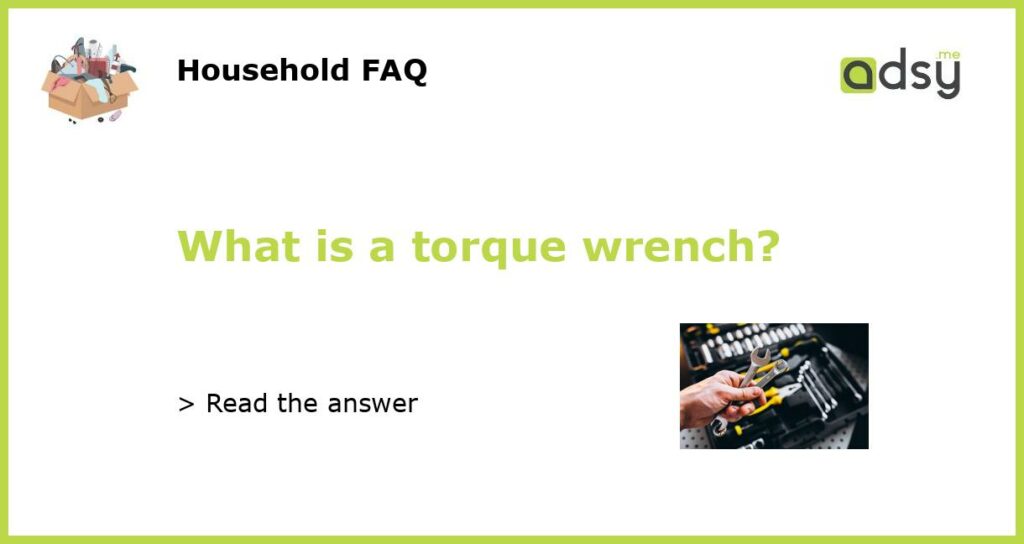Understanding the Basics of a Torque Wrench
When it comes to working with tools, one name that often comes up is a torque wrench. But what exactly is a torque wrench? In simple terms, it is a tool used to tighten or loosen nuts and bolts to a specific torque setting. Let’s delve deeper into the world of torque wrenches to understand their purpose, types, and how they work.
The Purpose of a Torque Wrench
A torque wrench is specifically designed to achieve accurate torque measurements while tightening fasteners. This is crucial in industries such as automotive, aerospace, and engineering, where precise torque application is essential to avoid under or over-tightening. Applying the correct torque is important for safety, preventing damage to components, and ensuring optimal performance.
Types of Torque Wrenches
There are several types of torque wrenches on the market, each with its own unique features and applications:
- Beam Torque Wrench: This is the simplest and most basic type. It features a lever arm with a pointer attached to it. As torque is applied, the pointer moves along a scale indicating the amount of force.
- Click Torque Wrench: This type produces an audible click sound when the desired torque is reached. It is widely used in various industries and is available in different designs, such as the deflecting beam, dual beam, and micrometer adjustable.
- Digital Torque Wrench: This modern version of the torque wrench offers a digital display to accurately measure and display torque readings. It often comes with additional features like data storage and the ability to choose different torque units.
- Hydraulic Torque Wrench: This type of wrench uses hydraulic pressure to tighten or loosen fasteners. It is commonly used for heavy-duty applications and in industries where extremely high torque is required.
- Angle Torque Wrench: Unlike other types, angle torque wrenches measure torque by the degree of rotation. They are frequently used in specialized applications where accurate angle measurements are crucial.
How Does a Torque Wrench Work?
A torque wrench uses various mechanisms to ensure accurate torque application:
- Spring Mechanism: The most common mechanism found in torque wrenches is the calibrated spring. The wrench is pre-set to a specific torque value by adjusting the spring tension. When the desired torque is reached, the spring deflects, triggering the click sound or stopping the tightening process.
- Hydraulic Mechanism: Hydraulic torque wrenches use hydraulic pressure to apply torque. The wrench has a hydraulic multiplier that increases the force applied by the user, making it suitable for heavy-duty applications.
- Electromagnetic Mechanism: Some advanced torque wrenches use electromagnetic technology to measure torque. These wrenches are typically more accurate and provide real-time torque measurements.
- Angle Mechanism: Angle torque wrenches measure torque by the degree of rotation. They have a built-in sensor that tracks the angle of rotation, ensuring precise tightening in applications that require specific angles.
Tips for Using a Torque Wrench Safely and Effectively
Using a torque wrench correctly is crucial to obtain accurate torque readings and avoid costly mistakes. Here are some essential tips to keep in mind:
- Read the Manual: Always start by reading the instruction manual provided by the manufacturer. This will give you important information about the specific wrench, including proper usage, maintenance, and safety precautions.
- Choose the Right Torque: Make sure you know the recommended torque for the fasteners you are working on. Consult the service manual or use a torque specification chart to find the correct values.
- Calibrate Regularly: Torque wrenches need regular calibration to ensure accuracy. Follow the manufacturer’s recommendations for calibration frequency or have it calibrated by a professional if necessary.
- Apply Steady Force: When using a torque wrench, apply consistent and steady force in the direction indicated on the wrench. Jerky or sudden movements can lead to inaccurate torque readings.
- Store Properly: Store your torque wrench in a clean and dry place to prevent damage and maintain its accuracy. Avoid dropping or mishandling the wrench, as this may affect its performance.






